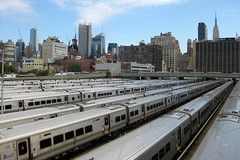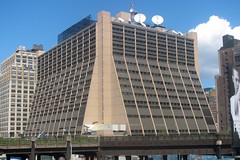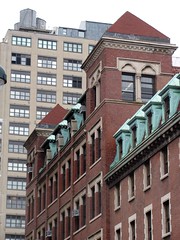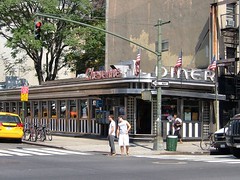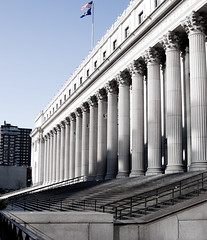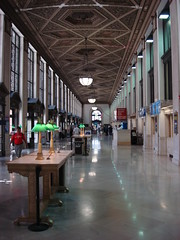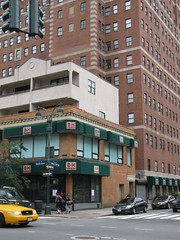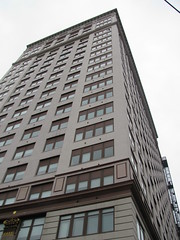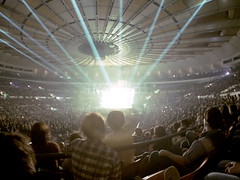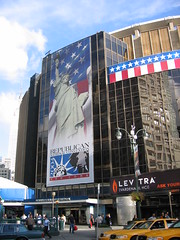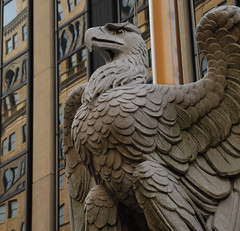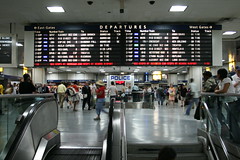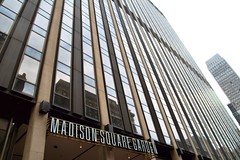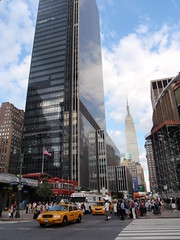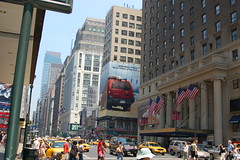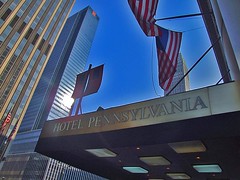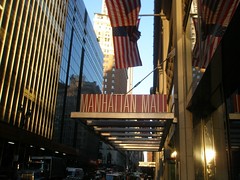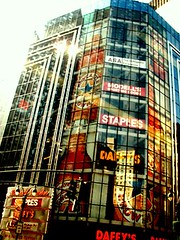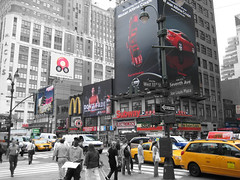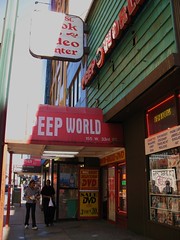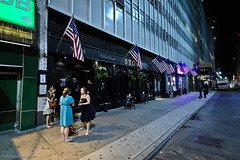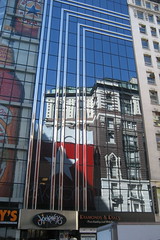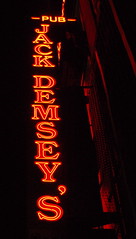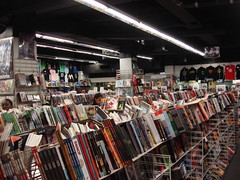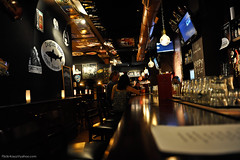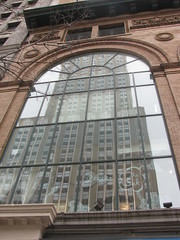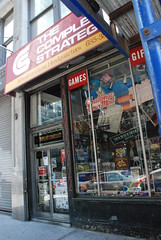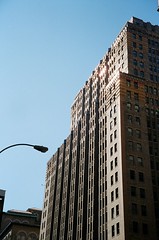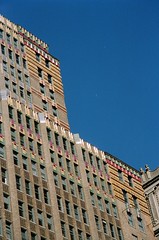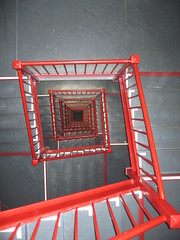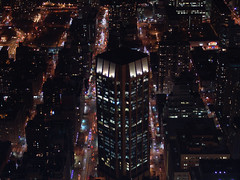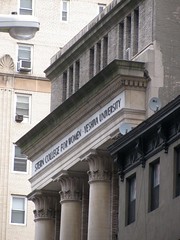North:
Herald Towers
Corner (1300 Broadway):
 AKA McAlpin House,
built as the Hotel McAlpin
in 1913, at the time the largest hotel in New York;
noted for its "silent floor"
for the nocturnal. Converted to apartments in 1979;
the murals of New York Harbor in the hotel's
Marine Grill were removed and installed in the
Fulton Street subway stop. At this corner is
Game Stop, software retailer.
AKA McAlpin House,
built as the Hotel McAlpin
in 1913, at the time the largest hotel in New York;
noted for its "silent floor"
for the nocturnal. Converted to apartments in 1979;
the murals of New York Harbor in the hotel's
Marine Grill were removed and installed in the
Fulton Street subway stop. At this corner is
Game Stop, software retailer.
49: Korea Exchange Bank
45: People's Voice Cafe
43: Yang Pyung Seoul Restaurant, a mini-chain
named for a Korean TV actor. Specializes in
hae jang gook, touted as a hangover cure. Also
Empire Exotics.
35: Once the address of Major's Cabin Grill, where in
1950 lawyer
Frank X. McNamara was once short of cash to pay his bill and as
a result founded Diner's Club.
33:
Zoni Language Center; claims to be largest private
English language school in the metropolitan area.
In the gaslight era, this was the address
of the House With Bronze Doors, a
ultra-posh gambling den designed by Stanford
White. The doors in question came from a
Venetian palace.
19: Empire State Station Post Office;
Louis Shoe Rebuilders, since 1921.
Big Apple Delicatessen & Restaurant, Daikichi Sushi--two
possibilities if you want to eat in the big building.
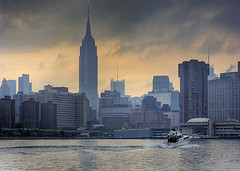
This block was the site of two mansions
owned by the Astor family--the
northern half was owned by Caroline (Mrs. William) Astor, whose
annual parties literally defined New York
society; the ballroom could hold 400
guests, and these "Four Hundred" were considered the who's who.
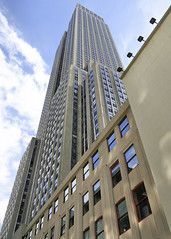
The southern half held the mansion of her
nephew, William Waldorf Astor,
which inspired the fashion for mansard roofs. Feuding
over who had the right to
be referred to as "Mrs. Astor," the nephew in 1893
replaced his house with the Waldorf Hotel,
designed by Henry Hardenbergh,
in order to spite his aunt. (Waldorf was John
Jacob Astor's hometown in Germany.)
Caroline Astor responded by replacing her own home with the
Astoria Hotel, also designed by Hardenbergh,
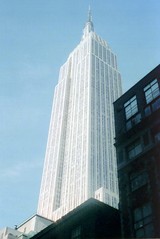 which were combined in 1897 to create the Waldorf-Astoria (though
Caroline insisted on the right to re-separate the hotels at any time).
The hotel catered to the super-wealthy; B.C. Forbes, of Forbes magazine,
used to have a regular poker game there with Henry Clay Frick and other plutocrats.
U.S. Steel was born at the hotel in 1901. The Waldorf salad was
invented there in 1896, and Thousand Island dressing
popularized; the Gibson and the Rob Roy
were created at the Bull & Bear Bar here. In 1929 the
hotel relocated uptown, and the Empire State Building was built on this site.
which were combined in 1897 to create the Waldorf-Astoria (though
Caroline insisted on the right to re-separate the hotels at any time).
The hotel catered to the super-wealthy; B.C. Forbes, of Forbes magazine,
used to have a regular poker game there with Henry Clay Frick and other plutocrats.
U.S. Steel was born at the hotel in 1901. The Waldorf salad was
invented there in 1896, and Thousand Island dressing
popularized; the Gibson and the Rob Roy
were created at the Bull & Bear Bar here. In 1929 the
hotel relocated uptown, and the Empire State Building was built on this site.

With ground broken on January 22, 1930, the building took only a year and 45 days
to complete. The architect, William Lamb, said his design was inspired by a pencil.
At 102 stories and 1,454 feet, it was the tallest building in the world from
1931 until 1974; there are still only three buildings in the world with more floors.
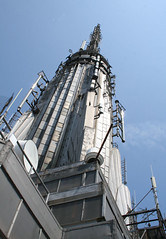
The mast on top was supposed to be a mooring
tower for dirigibles, but the idea
was abandoned after only one attempt due to
chronic high winds--and dirigibles were
on their way out anyway. (See Sky Captain and the
World of Tomorrow for a gorgeous depiction of an ESB
zeppelin docking.) On July
28, 1945, a B-25 bomber flying through fog
crashed into the 79th floor, killing 11 people.
Allen Ginsberg briefly worked in an advertising office here.
The Heartland Brewery on the ground floor used to be a branch
of the Longchamps chain, decorated in Mississippi
riverboat style.
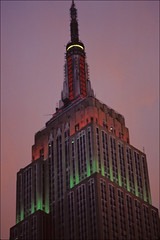
The building was famously climbed by the giant gorilla in
King Kong, and
was a meeting place for lovers in An Affair
to Remember, Sleepless in Seattle--
and in King Kong, too, I guess.
See the official guide to the colors of the
Tower Lights--and an annotated photograph of the northern view.
| 